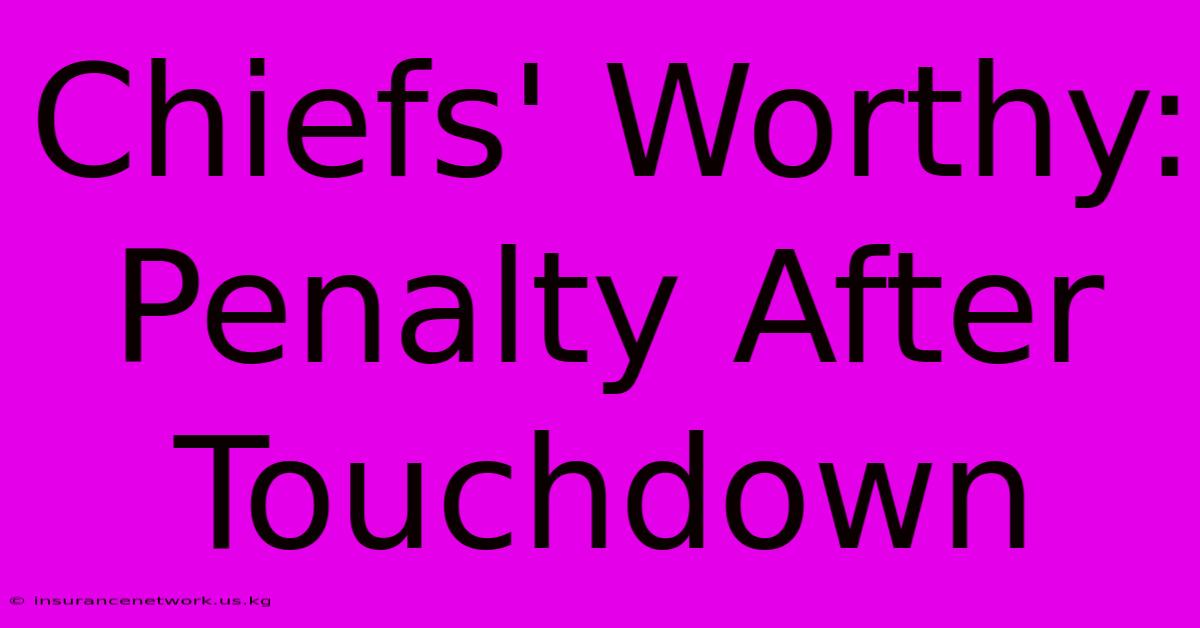Chiefs' Worthy: Penalty After Touchdown

Discover more detailed and exciting information on our website. Click the link below to start your adventure: Visit Best Website insurancenetwork.us.kg. Don't miss out!
Table of Contents
Chiefs' Worthy: Penalty After Touchdown - Understanding the NFL's Confusing Rules
The Kansas City Chiefs' recent game highlighted a frustrating and often confusing aspect of NFL rules: penalties assessed after a touchdown. This situation, where a team celebrates a score only to have it marred by a flag, leaves fans scratching their heads. Let's break down the specifics, explore why these penalties occur, and clarify the often-misunderstood implications.
Understanding the Post-Touchdown Penalty Process
The core principle is simple: penalties are enforced regardless of the score. A touchdown doesn't erase a preceding infraction. Whether it's unsportsmanlike conduct, holding, or a personal foul, the penalty will be assessed. This can result in several scenarios:
Scenario 1: The Touchdown Stands, but Yardage is Lost
This is the most common outcome. The touchdown is counted, but the ensuing kickoff starts further back due to the penalty yards. For example, a 15-yard unsportsmanlike conduct penalty after a touchdown means the opposing team's kickoff begins 15 yards deeper in their own territory. This can significantly impact field position and the overall game strategy.
Scenario 2: The Touchdown is Nullified
In rare cases, a penalty can negate the touchdown entirely. This typically happens if the infraction directly caused or prevented the score, such as an offensive holding call that allowed the receiver to get into the endzone. In this instance, the touchdown is removed from the scoreboard, and the down is replayed from the spot of the foul. Imagine the heartbreak!
Scenario 3: Confusing situations leading to debates
The post-touchdown penalty application can sometimes result in situations that seem unfair or contradictory. These inconsistencies can often lead to discussions and disputes, and it often depends on the referee's interpretation of the rules and the specific context of the penalty. This adds to the complexity for fans and players alike.
Common Penalties Leading to Post-Touchdown Frustration
Several penalties frequently lead to this post-touchdown disappointment. These include:
-
Unsportsmanlike Conduct: Excessive celebration, taunting, or other actions deemed unsportsmanlike by the officials. This is often the source of frustration for players and fans alike.
-
Holding: Offensive or defensive holding can be called even after a player has reached the end zone, negating the touchdown in some instances, or resulting in a loss of yardage for the extra point attempt.
-
Personal Fouls: Late hits, roughing the passer, or other personal fouls often lead to significant yardage penalties after a touchdown.
-
False Start: While less common immediately after a touchdown, a false start on the extra point attempt results in a replay of the attempt.
The Impact on Game Strategy and Momentum
The impact of post-touchdown penalties can be substantial. Losing yardage on the ensuing kickoff or having the touchdown completely nullified can swing momentum significantly. It adds another layer of complexity to coaching decisions and player discipline.
The Importance of Sportsmanship and Discipline
The best way to avoid these frustrating situations? Discipline and sportsmanship. Players need to celebrate responsibly, adhering to the rules to avoid penalties that can change the course of the game.
While the rules surrounding penalties after touchdowns can seem confusing, understanding the basic principles helps to clarify the often-unpredictable outcomes. For fans, it's a reminder that the game's intensity continues even after a score, and for players, a constant reminder of the importance of discipline. Ultimately, these penalties highlight the ongoing balance between celebrating success and adhering to the rules of the game.

Thank you for visiting our website wich cover about Chiefs' Worthy: Penalty After Touchdown. We hope the information provided has been useful to you. Feel free to contact us if you have any questions or need further assistance. See you next time and dont miss to bookmark.
Featured Posts
-
Nba Christmas Day 2024 Games Tv Schedule
Dec 26, 2024
-
Swift Skips Chiefs Steelers Game
Dec 26, 2024
-
Kelces Td Record Past Gonzalez
Dec 26, 2024
-
Swift In Pittsburgh For Chiefs Game
Dec 26, 2024
-
New Happy Gilmore Trailer Sandler Back
Dec 26, 2024
